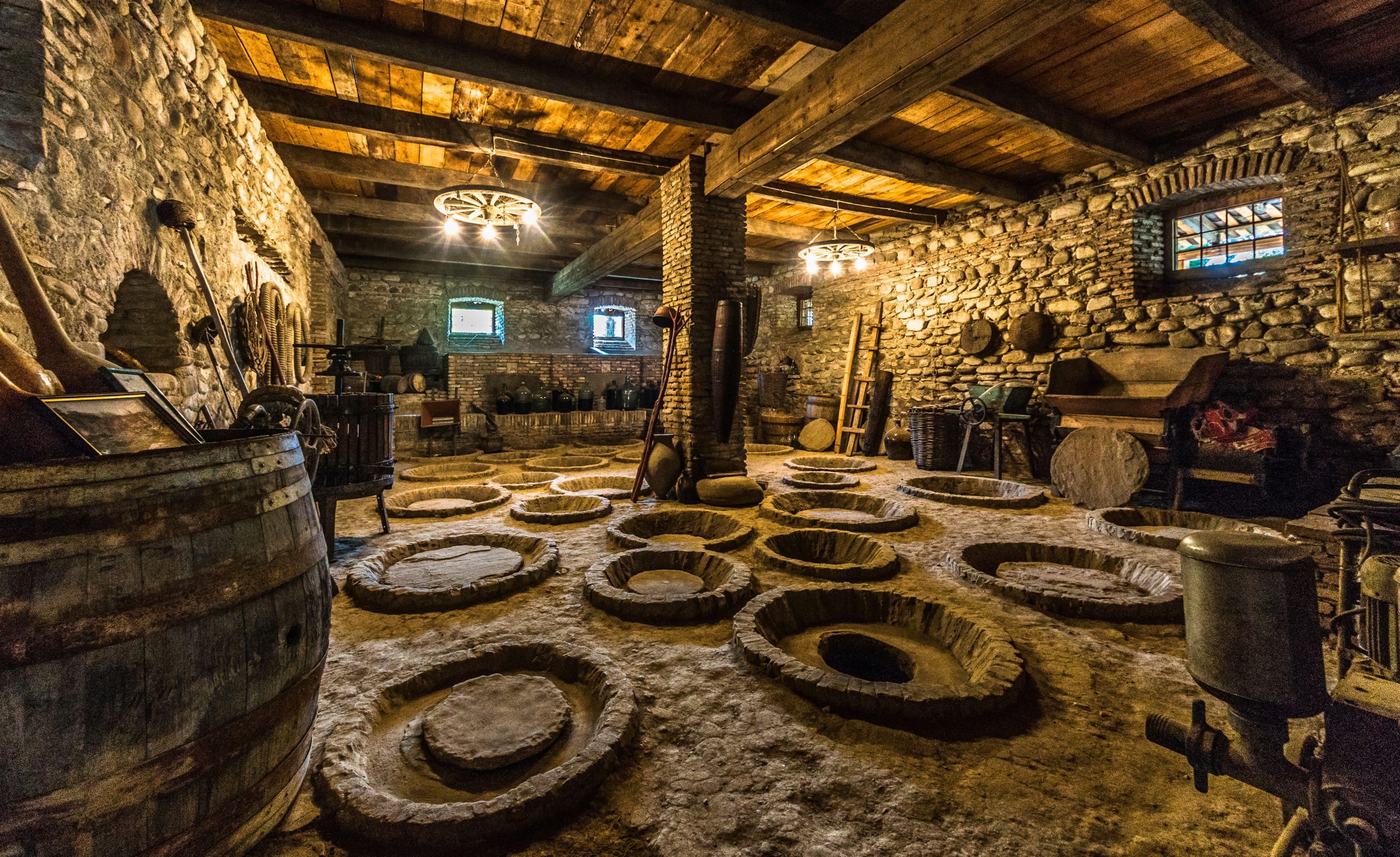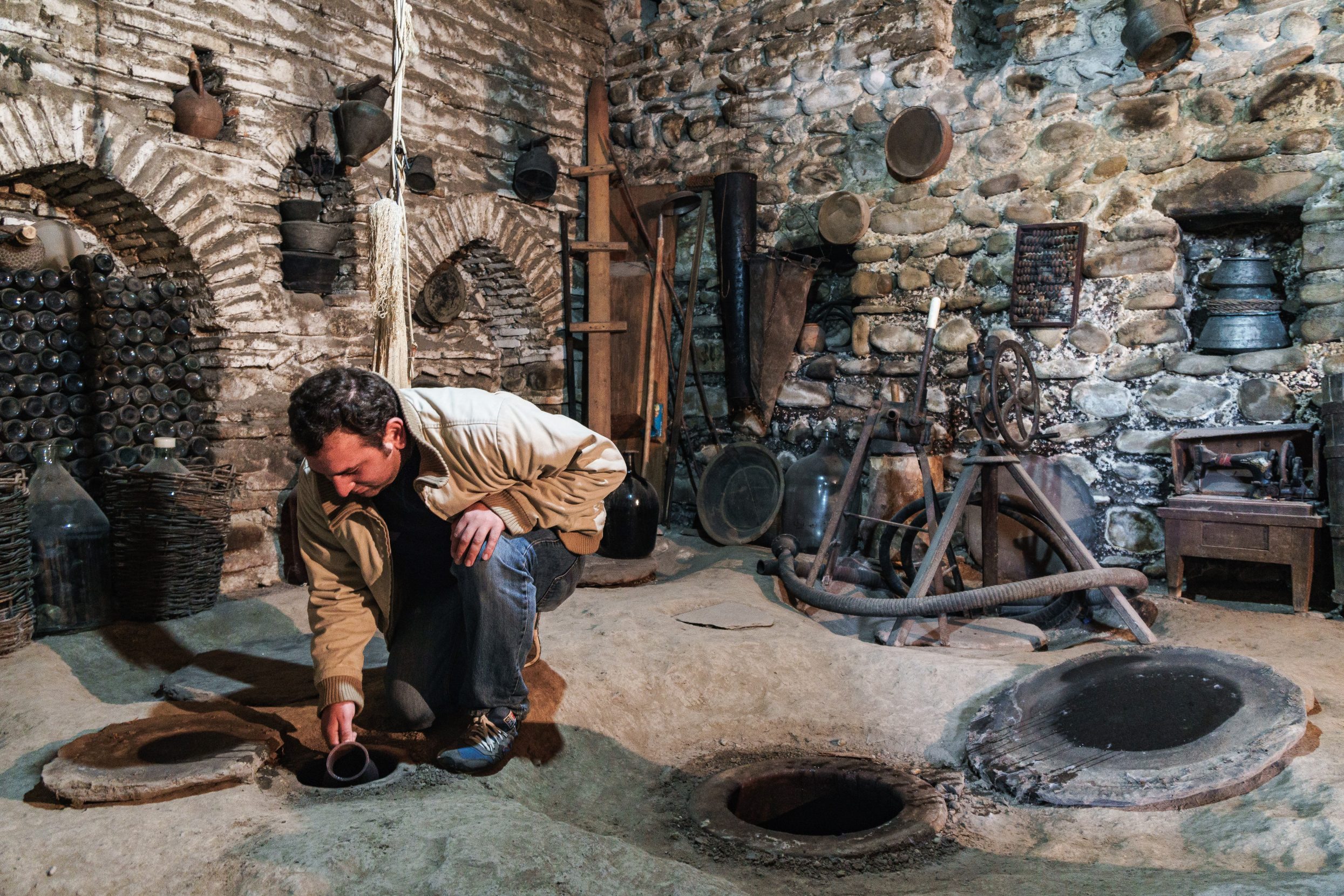Support Hidden Compass
We stand for journalism, science, history, and hope. Make a contribution to Hidden Compass and stand with us.
The subterranean air was thick and dank. A lightbulb hanging from the ceiling cast ominous shadows on the stone walls.
I crowded into a circle of strangers and peered into a large, teardrop-shaped clay vessel, one of many buried in the groundwater around me. Each qvevri (pronounced “KWEH-vree”) represents millennia of winemaking tradition unique to Georgia.
In the hallowed wine cave of the family-owned Ancestral Wine Cellar, outside of the picturesque town of Sighnaghi, I felt as if I were inside a church, stepping up to the altar of wine, as the patriarch of the winery, dressed in robes, welcomed the faithful.
His daughter, Tamar, pointed to a qvevri large enough for a person to crawl inside. Indeed, she explained, crawling inside was exactly how they cleaned the vats between fermentation cycles. To make the wine, they fill the pots with yeast and grapes — skin, stems, leaves, and all. The shape of the qvevri allows the sediment to settle to the bottom, while the pottery’s arable quality ensures proper fermentation. Sometimes lined in beeswax, the vessels are buried and left to do their magic in the coolness underground.

In cellars across Georgia, wine ages the traditional way — buried underground in large clay pots, called qvevri. In the historic village of Velistsikhe, this family-owned wine cellar dates to the 16th century. Photo: Vincent Rowell.
There they stay for at least six months. During that time, the vessels can break; the wine could sour; many things could go wrong. Each unsealing is a matter of chance.
It wasn’t just the high ceilings and columns that filled me with reverence. Built in 1871, the space exuded an intangible essence: the promise of communion, centuries of human ingenuity.
Touching the cold stone, I imagined traveling back thousands of years into history — my hands and this clay forming a physical link, a connection to the people who went to all the trouble to farm the grapes, stomp on them, and leave them in naturally hewn vessels to ferment; their patience with time and their faith in tradition turning fruit into wine.
That history promised not only connection, but also understanding.
~~
I was raised not to question alcohol’s place in daily life — the beer by my father’s dinner plate was as standard as the wine on the church altar. But it’s still difficult to fathom how far back humanity’s drinking roots go.
Long before we invented the written word, Homo sapiens figured out how to get drunk.
When I first read that Georgians had been making wine for more than 8,000 years, I thought there must have been a typo — an extra zero added by accident. But this astonishing number was true. In 2017, archaeologists uncovered evidence in circular, mud-brick homes south of Tbilisi. In these ancient dwellings, chemical analysis detected tartaric acid — the fingerprint compound for wine grapes — in the residue inside large clay jars, including one that was three feet tall: possible proto-qvevri.
Circa 6,000 B.C.E., Neolithic people in Georgia settled into villages at Gadachrili Gora and Shulaveris Gora, cultivating crops, making stone tools, and developing crafts. In the midst of their relatively comfortable lives, they also started fermenting wine. Not only did they manipulate the fruits, but these prehistoric descendants of hunter-gatherers figured out how to improve, store, harvest, and ferment what is now known as the “European grape,” Vitis vinifera, inside large pots they created for just that purpose.
This is not the Stone Age I had ever imagined. Now, I picture a bearded vintner, carefully planting his vines, cupping the grapes in his hand, smelling and tasting to get that perfect combination of fruit, earth, time.
I came to Georgia because I wanted to taste that 8,000-year-old flavor, to personally partake of its elusive history — and to find out if I could discover what has driven people to drink throughout the ages.
~~
My journey with alcohol started early: I was 4 years old, a mud-covered tomboy thirsty from running around in the sun, when my dad handed me a chilled summertime Pilsner.
I inherited my father’s love of drink but my mother’s inability to handle it. During Eucharist, my cheeks would flush red after a single sip from the bejeweled chalice. I’m missing the enzyme that processes alcohol. Although I love the taste of wine and all kinds of fermented beverages, my body keeps me from joining the long line of cousins making their way through AA meetings.
Drinking has always been a social lubricant in my culture. On my 21st birthday, my dad’s unfettered joy was palpable as he took my older sister and me out for makgeolli, a traditional Korean rice wine. While seated at the bar, he gleefully put his arms around us and said how happy he was to finally drink with both his daughters, legally.
Age restrictions on alcohol have always struck me as strange, considering how many millennia humans have been drinking it. Vessels in Jiahu, China, showing residual evidence of a crude sort of rice wine, date a thousand years earlier than those Neolithic Georgians began making wine out of grapes. Long before we invented the written word, Homo sapiens figured out how to get drunk. Even our ape ancestors waited until certain fruits had fermented into alcohol to eat them. That’s how important inebriation is to primates.
Surely such a biological urge isn’t about alcohol’s psychotropic properties alone. I hoped Georgia’s qvevri might unearth some answers.
~~
In the hills and valleys of the abundant Kakheti region, wild vines wind up from cracks in cobblestone streets. Pomegranate trees emerge in crevices between buildings and vacant lots.
Even though it’s only one of a patchwork of 24 different wine-making areas, most of the country’s wine is made here in Georgia’s easternmost swath of land. It’s as if the plants can’t help themselves, and the people are just there to gather the natural bounty.
This bucolic scene belies a turbulent history.
When Soviets invaded in 1921, the victors pulled up hundreds of indigenous grapes and planted only a few varieties, chosen more for their hardiness than their tastes. The Bolsheviks increased production and nationalized winemaking to produce 200 million liters a year, trading tradition for quantity. In the decades that followed, Georgia produced the majority of the Soviet Union’s wine. While Ukraine was the breadbasket of the USSR, Georgia was its wine cellar.
But that wasn’t enough for Georgia to be saved from Stalin’s wrath. The region suffered horrific bloodshed during Soviet rule. They also nearly lost the thread that tied them to their ancestors, and to their land.
~~
As the keeper of my family’s photos, history, and documents, I understand the importance of preserving links to our past. Once, I came across one of my dad’s pictures: a black-and-white image from the 1960s. My dad is sitting around an outdoor table with a group of guys — cups raised in a toast, faces smiling at the camera. They looked like old friends. But when I asked Dad who the men were, he couldn’t remember. I couldn’t resolve this scenario in my mind: How could he forget these people with whom he had shared such good times?
In Georgia, I started to understand.
At the Twins Wine Cellar in the scenic village of Napareuli, the vineyard’s namesake twins, Gia and Gela Gamtkitsulashvili, spoke at length about their vineyard. After quite a long talk, I turned to my translator to ask what they said.
He shrugged and said it wasn’t important. Raising a glass in toast, he said, “Let’s drink!”
The amber liquid caught the sun in a warm glow. The wine was dry and acidic, but also full bodied, with hints of fruit. As I looked out onto the grapevines stretching in the sun, it felt as if I was drinking up the late afternoon.

Traditional wine culture looms large in Georgian life, as encapsulated in this car decorated to promote a bar in Tbilisi. In addition to the qvevri pot on top, the billboard on wheels pays homage to native son and famed primitivist painter Niko Pirosmani, who frequently depicted scenes of rural life centered on wine traditions. Photo: Tuul and Bruno Morandi/Alamy.
The next day, during lunch at Pheasant’s Tears, a winery and restaurant in Sighnaghi, I bonded with the chef, Gia Rokashvili, over our shared love of growing plants and cooking. Although we did not speak much of a common language, we communicated with photos, gestures, flavors, and sips. Wine glasses in hand and joking like old friends inside the safety of the brick-lined walls, we shared details about meals past, present, and future.
Bent over his glass, the chef’s bald head reminded me of my dad’s shiny dome. But it was more than cranial similarity he shared with my father. Both men give the initial impression they are tough guys: taciturn and unapproachable. They are both quiet men who turn gregarious once filled with wine. Drinking sets them at ease.
It was well past midnight and my parents weren’t home yet. Eventually, around 2 a.m., red and blue lights flashed through our windows.
As they eagerly top off the glasses of their guests, conversations flow as freely as liquid pouring out of bottles.
~~
Even before the Soviets, centuries of occupiers tried to stifle Georgia’s traditions. They all failed. When fleeing their homes during countless invasions — whether by Romans, Greeks, Mongols, Turks, Persians, or Russians — Georgian vintners knew to save their vines to begin anew elsewhere. Their foresight helped preserve over 500 varieties of indigenous grapes — a spectacular range, bigger than anywhere else in the world.
The most popular native grapes are the Saperavi, used to make a robust red wine, and the Rkatsiteli, which produces the dry, “orange” wine that qvervi producers are known for.
Just as grapevine cuttings provided a lifeline for Georgia’s viticulture, safeguarding traditional wine-making methods required a group effort — an amalgam of knowledge passed down through families and preserved by individual winemakers.
In Georgia, much of the sacred duty of stewarding ancient ways has always been taken on by Orthodox monks, such as those who live at the medieval Shavnabada Monastery, high on its namesake mountain outside of Tblisi.
Shavnabada monks produce about 150,000 bottles of wine, mostly for export to Ukraine and Italy. Not wanting to let any of the precious grapes be wasted, they also distill a grappa-like drink. Known as chacha, it is made from aging the leftover dregs of white wine production in oak barrels or qvevri.
Like the vines revered inside its frescoed walls, Shavnabada is itself a testament to resilience. The original monastery was built in the 12th century, restored five centuries later, and shut down again by the Soviets. Upon Georgia’s regained independence, the monastery reopened, and the monks set to work reviving its wine cellar.
~~
One night, after a languid afternoon tasting some Rkatsiteli wine on the rooftop of a stone castle, overlooking a valley where vineyards unspooled in every direction, my travel companions and I got caught in a downpour on our way down the mountain. The rain pounded as we skidded along the perilous, winding road back to our hotel. Some people were angrily yelling at the driver to slow down. I sat silently in the back. The anger and the rain reminded me of a stormy night when I was in high school.
It was late and my sister and I were upset. We couldn’t sleep because it was well past midnight and my parents weren’t home yet. Eventually, around 2 a.m., red and blue lights flashed through our windows.
Alarmed, we ran out of the house in our bare feet and pajamas to find my parents, followed by cops. My dad had been pulled over for drunk driving — again. Since he had insisted on driving himself, the police had escorted them home. Once again, my sister and I felt like the responsible ones, as our parents behaved like partying teenagers.
~~
The morning after our stormy drive in Kakheti, everyone was quiet and sober. The weather was sunny and clear, perfect for visiting Chateau Mukhrani, the former estate of the Georgian royal family, in the valley between the Caucasus and Trialeti mountain ranges.
Manicured lawns, sleek metal tanks, and a temperature-controlled warehouse greeted us — a sharp contrast to the quaint intimacy of the qvevri wineries we had visited up until then.
In 1876, Prince Ivane Mukhranbatoni traded a military career for viticulture. Following a trip to France’s winemaking regions of Bordeaux and Champagne, he established a vineyard on his family’s ancestral estate.
Today, the legendary label embodies modern winemaking in Georgia, relying on an alchemy of imported techniques, native Georgian grapes, and European varietals. Here, nothing is left to chance or the whims of nature. Scientists have figured out the optimum temperature for fermentation, the proper terroir, the right combination of grapes.
The wine tasted predictable and smooth — enjoyable, but so removed from the exciting earthiness of traditionally produced vintages.
In 2006, a Russian embargo took a devastating economic toll on Georgia’s wine industry, eliminating about 90 percent of the export market overnight. Many Georgians believe Vladimir Putin aimed to punish the nation for its aspirations to join Western Europe. The unintended consequence of the seven-year ban: Georgia was forced to find new trading partners that proved an accidental boon to the quality and diversity of its wine exports.
In order to distinguish their vintages from the competition, local vintners turned the traditional method, using qvevris and macerated grapes, into a commercial venture.
Qvevris give us a direct link to the origins and history of winemaking, but they are painstakingly slow and labor-intensive to make. The vats are made by hand, without molds, lined with resinous propolis or beeswax, and painted with lime on the outside. Qvevri potters are a dying breed: Only a few still know how to make these vessels, having learned from their fathers, who learned from their fathers before them.

A man pulls a sample of wine from an underground vat at a wine cellar in the Kakheti winemaking region of Georgia. Photo: James Strachan/Alamy.
Traditional qvevri wine is more tannic and bolder, due to the addition of the grape skins and even stems. Already organic and biodynamic, this wine, rooted in centuries of tradition, dovetails beautifully into a modern trend.
Even so, most of the country’s exported wine is now made by more modern methods. But it’s not fair to lament the changes from an outsider’s perspective. Romanticizing the past only hurts modern makers.
Contemporary palates and consumption demand more consistency and volume. In response, Georgian winemakers are experimenting with different methods, trying sparkling wines and even producing rosés from indigenous grapes.
“Today, many producers are informed by tradition but not trapped by it,” says Lisa Granik in The Wines of Georgia.
It’s a familiar conflict: consistency versus character. Time-honored traditions versus mass production. But the different facets aren’t always opposing — they’re all part of the same story, a story of the human spirit that strives to innovate, to grow. We strive not to sever the ties to our past, but to strengthen those connections while we reach for a brighter future.
~~
Back home in California, I drive my dad, now in his 80s and sick, to the doctor’s office. I monitor his treatments and serve as his translator. Of all the twists and turns our relationship has taken over the decades — the highs and lows, both sober and under the influence — his cancer diagnosis a decade ago turned out to be the biggest surprise, a blessing in disguise.
Like the slow turning of grapes into wine, our conversations have deepened little by little with the passage of time, revealing tiny bits of information, like unearthing a history I didn’t know I was excavating.
Alcohol, much like a father-daughter relationship, isn’t black and white. It’s not an elixir, and there is nothing supernatural in inebriation, either. But there is power in the multilayered connections that drinking can facilitate.
The magic comes in the slow revealing of secrets, the lowering of expectations and by breaking the barriers we build around ourselves. Drinking together, like any other tradition passed down through the ages, has a way of helping us put our guard down. Glasses in hand, we face each other in a truce, not as enemies.
~~
Back at the wine cave, the moment had come to unseal the qvevri. Tamar lit the candle on the sacred vessel and poured a bit of wine onto flatbread imprinted with the ancient Georgian symbol of the sun. It was a gesture of good luck and something like a sacrifice to the gods of wine. Her father sang a song I couldn’t understand, but I felt the melody oddly familiar, deep in my bones. With our breaths held, we waited for the seal to be broken.
It’s a familiar conflict: consistency versus character. Time-honored traditions versus mass production. But the different facets aren’t always opposing.
Like a golden treasure hiding underground, the vat of wine was nicely aged. The group exhaled a collective sigh of relief.
Naturally, we celebrated by drinking the wine on a rooftop overlooking the Alazani River Valley. The Caucasus spread out in the distance — far enough away to look like a landscape painting from long ago. An array of khachapuris (flatbreads), grilled meats, sauces, and vegetables topped the table.
Circled around the bounty, there were over a dozen of us — all from different corners of the Earth, each with our own complex histories. But in that intimate moment, the sharing of wine transcended cultures and language. We were just a group of people drinking and eating together, as those before us have done for centuries and those after us will share, again and again for centuries to come.
Cecilia Hae-Jin Lee
Cecilia Hae-Jin Lee is a wordmonger, conceptual artist, sharer of food, and professional accidentalist. You might catch a glimpse of her climbing a mountain, planting seeds, running in waves, baking cake, or staring at clouds — laughing all the while.
Never miss a story
Subscribe for new issue alerts.
By submitting this form, you consent to receive updates from Hidden Compass regarding new issues and other ongoing promotions such as workshop opportunities. Please refer to our Privacy Policy for more information.



